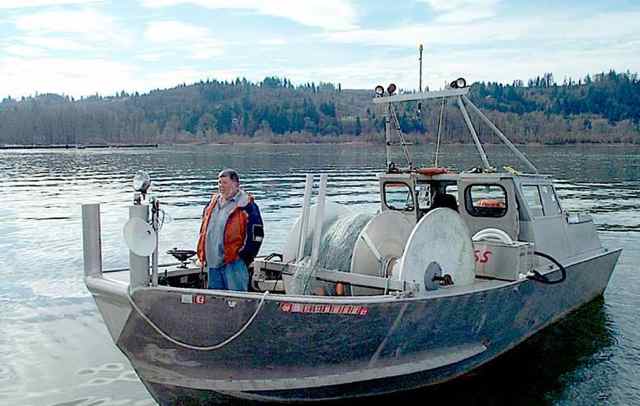forum
library
tutorial
contact

Lower Columbia Gillnetters
Hit the River for Spring Chinook
by CBB StaffChinook Observer, April 1, 2016
|
the film forum library tutorial contact |

|
Lower Columbia Gillnetters
by CBB Staff |
Bonneville passage slow so far
 Recreational anglers took a day off fishing for spring Chinook on March 29, but that didn't give the fish a rest as the day-long gap was filled by nine hours of commercial gillnetting. Anglers were back fishing Wednesday morning, March 30.
Recreational anglers took a day off fishing for spring Chinook on March 29, but that didn't give the fish a rest as the day-long gap was filled by nine hours of commercial gillnetting. Anglers were back fishing Wednesday morning, March 30.
The two-state Columbia River compact set the commercial fishing period at its meeting March 28, just in time for up to 100 gillnet boats to begin fishing March 29 for the highly-valued spring Chinook from Astoria to Bonneville Dam.
The compact had set openings and regulations for spring Chinook and steelhead fishing for recreational anglers at its annual joint-state hearing in late January. Expecting a higher than average run of spring Chinook, the compact opened Chinook fishing to recreational anglers on the river below Bonneville dam beginning March 1 and allowing fishing through April 9.
At the same meeting, the compact identified two days that would be closed to recreational fishing -- March 29 and April 5 -- allowing commercial gillnetters time to fish the mainstem river.
The spring Chinook season is based on a US v Oregon Technical Advisory Committee forecast of 299,200 returning spring Chinook to the river's mouth. That includes an estimated 188,800 upriver spring Chinook. The 2015 return was 415,200 spring Chinook, far higher than the 10-year average return of 285,000 fish.
It's not certain yet that the run size will live up to expectations. As of March 31 just 190 spring Chinook had passed Bonneville Dam, according to the Fish Passage Center (www.fpc.org). The 10-year average for that date is 291.
The size of the allowed catch of spring Chinook for commercial gillnetters in the mainstem river this early in the season is based on the number of upriver spring Chinook expected prior to a forecast update by TAC.
According to compact staff that number is 1,222 adult upriver fish and they expected a catch of about 1,200 fish, including about 900 upriver fish (about 71 percent of the total catch and 19 percent of the federal Endangered Species Act impact allowed before the forecast update) to be landed during the 9-hour period.
Wild winter steelhead mortalities are expected to be fewer than 50 fish (less than 0.3 percent impact), or 15 percent of the 2 percent impact limit for wild winter steelhead, the staff said.
Also, the Oregon Department of Fish and Wildlife estimated in December that the run of spring Chinook salmon into the Willamette River would be 70,100 fish, higher than the 2015 forecast (55,400), but lower than 2015's actual return of the fish (87,100). The 10-year average is 61,000 fish.
Compact staff said an additional 7,150 Willamette hatchery spring Chinook are available to commercial fisheries for the 2016 spring season, but access to these fish will be constrained by the commercial upriver Chinook allocation.
Also constraining the timing of commercial fishing is the number of wild winter steelhead still in the river. Winter steelhead abundance typically peaks in mid-March, then declines as the fish move into the tributaries. Passage at Bonneville Dam and Willamette Falls indicates the run is tracking generally within expectations given the forecast of nearly 17,000 wild fish, staff said.
Some 2,678 winter steelhead and 1,176 wild winter steelhead have passed the dam as of March 30.
Test gillnetting by the states has been showing a rising number of Chinook in the test nets, while the number of steelhead per drift has been falling.
"Based on the increasing number of Chinook per drift, the lower number of steelhead encountered, the high Chinook mark rate and the March 29 sport angling closure," staff recommended the 9-hour opening Tuesday.
Gillnetters must use 4.25 inch maximum mesh gillnets and retain only adipose fin-clipped Chinook salmon and shad. Standard regulations typically in place for spring Chinook commercial fisheries are in effect, including but not limited to: net length, use of recovery boxes, limited soak times, red corks, lighted buoys, tangle-net certification, the staff recommended.
Previously this month, the compact opened the John Day pool February 1 to March 12, and the Bonneville pool March 12 to March 21, to fishing by tribal gillnetters.
Some gillnetting has already been allowed in select areas in the lower Columbia River, such as Youngs Bay and Blind Slough in Oregon, and Deep River in Washington, as part of the Columbia River harvest reform initiative adopted by both Washington and Oregon state legislatures in 2013.
The Oregon Fish and Wildlife Commission reviewed the reform's progress at its March meeting. The reform consists of harvest allocation shifts, with recreational fishing taking a larger chunk of the mainstem fishing, while commercial fishing would transition to select areas and new fishing gear and techniques by 2017.
An example of a new technique is actually an old but recently unused technique -- beach and purse seining -- which is attracting fewer gillnetters than expected. Fall seasons have resulted in some large catches, but ESA-listed steelhead mortality is higher than expected. The summer season is seeing moderate catches, but the number of ESA-listed sockeye salmon is high.
The next compact meeting to discuss recreational fishing of spring Chinook is scheduled for April 7.
TAC will update its forecast once it sees how the spring Chinook run actually develops and when it thinks the spring run is about 60 percent complete at Bonneville Dam. That update is likely to occur between May 2 and May 9.
learn more on topics covered in the film
see the video
read the script
learn the songs
discussion forum
